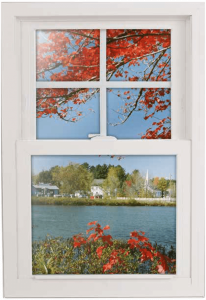Window Terminology
This week’s blog post is all about window terminology. We know the home renovation and remodeling business is chock-full of words that most people simply don’t understand, and we may use some terms that can be confusing to someone who doesn’t work in home improvement. So, to further educate our readers we’re going to break down some confusing window terminology. So without further ado, let’s learn about windows.
What Is A Double Pane Window?
Double pane windows, have two panes of glass. This gives them extra insulation. Generally speaking, more window panes offer your home better insulation, at greater expense and size. So triple pane windows generally insulate better than double pane, and so on and so forth. However, our HR40 window is different from all the competition. It’s a double pane, but with a little secret sauce – more on that at the end of this blog post.
What is a U-Factor?
U-factor measures the rate of heat loss. So, when you’re looking to buy windows, the lower the u-factor the better you’ll be able to keep your home heated. When our window reps come out to investigate your home’s windows this will be one of the first things they check. In fact, one of the best ways to measure the effect of windows on building energy is to check the U-factor rating as it explains energy loss for the entire window unit. When putting a HR40 window into your home the U-factor will be at an all-time low.
What is R-Value?
R-Value measures the resistance to heat loss. In this case, a higher number is better. The R-factor only accounts for the conductivity, so it’s not as effective a measure as U-factor. Windows that have good insulating values will make your home more comfortable, particularly in winter. This is partly because they allow less heat to pass through, but there’s another reason – the in
side surface of a better insulated window will be warmer. When you stand or sit by it, your body won’t lose as much heat to the window as it would to a colder surface. This is exactly what we do at shows and events with our empire state building challenge. You get to feel the comparison between our HR40 windows and a normal double e argon window.
What Are E-coatings?
E-coatings are metal or metallic oxide layers put on the surface of the panes of glass. They reduce the U-factor by reducing the infrared radiation from a warm pane to a cooler pane.
What Are Argon and Krypton Gas Fills?
Your windows have two sets of glass, an inside piece and an outside piece. Between the window panes is a small empty space. This space has air currents that carry heat to the top of the unit and  create cold pools at the bottom. If you fill the space with a slow-moving gas you can minimize the overall transfer of heat between the inside and outside. The two most popular gas fills are argon and krypton. Both are non-toxic, non-reactive, clear and odorless. Argon is cheaper to produce than Krypton, but Krypton generally gives a higher r-value, and low u-factor. This is why at Peoples Products we use the Krypton gas in our HR40 windows. Our main focus is having the best quality window, and that’s what we’ve done.
create cold pools at the bottom. If you fill the space with a slow-moving gas you can minimize the overall transfer of heat between the inside and outside. The two most popular gas fills are argon and krypton. Both are non-toxic, non-reactive, clear and odorless. Argon is cheaper to produce than Krypton, but Krypton generally gives a higher r-value, and low u-factor. This is why at Peoples Products we use the Krypton gas in our HR40 windows. Our main focus is having the best quality window, and that’s what we’ve done.
What Is Heat Mirror?
Heat Mirror technology is that “secret sauce” that we were talking about before, and it’s what makes the HR40 window super special. Sure, Krypton Gas and high quality ultra-clear gas make the HR40 window above-standard, but the heat mirror technology is what allows it for best-in-class efficiency. Heat Mirror film is suspended between the two panes, creating smaller spaces for the Krypton gas to insulate. And since Krypton gas better insulates in small, dense spaces, it magnifies its efficiency values. The Heat Mirror film also offers a degree of inherent UV protection, stopping damaging UV-rays from sun-bleaching your furniture and rugs.
For more more home improvement tip make sure to check back with us weekly, and for some “Door” terminology stay tuned for next week!
For more information on our home consultation: Peoples Products Consulation

